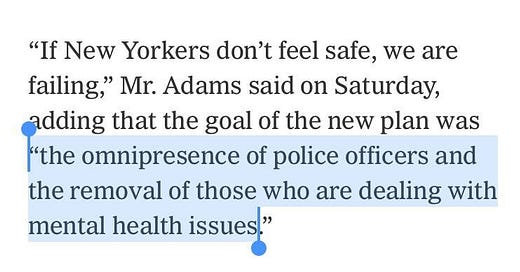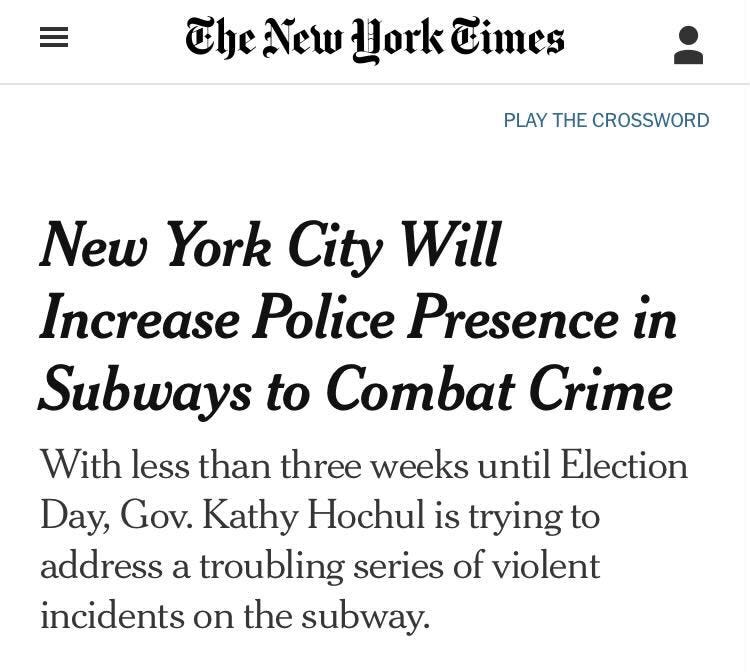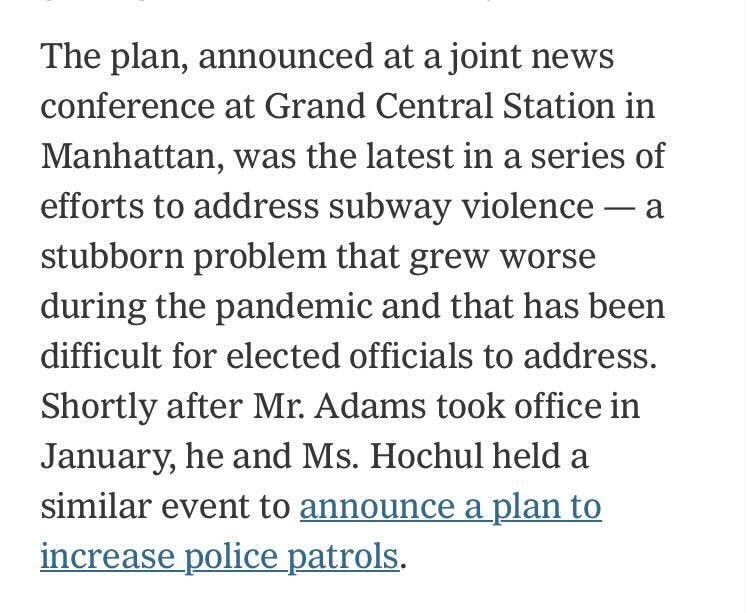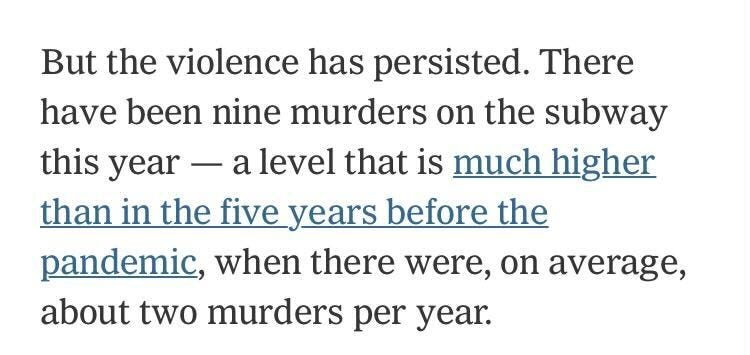The New York Times Spreads Misinformation Again
The largest corporate paper in the United States is becoming a gateway to fascism
This weekend, the New York Times published yet another article that models many of the dangerous media practices I’ve analyzed here. The stakes of this unethical reporting in this moment are enormous: not only is New York embarking on a project to dramatically militarize and surveil the subway and to expand the police bureaucracy, but the country as a whole is on the precipice of a far-right authoritarian takeover. It’s useful to discuss a few of the examples of exactly what the New York Times did because they are so prevalent and sometimes subtle.
What is the article about?
This weekend’s article is about a chilling plan by New York officials to dramatically militarize the subway, “flooding” it with armed government agents and surveillance cameras. Here are the Orwellian words of the New York City Mayor describing what they want to do: “omnipresence” of armed cops and a sort of cleansing of the subway system of human beings “dealing with mental health issues.”
The first problem: powerful people tell us things:
Take a look at the title:
Note that in both the headline and the sub-headline, the New York Times makes the classic unethical error of repeating as fact the stated motivations of politicians. The NYT says that the purpose of increasing police is “to combat crime” and that the Governor is “trying to address a troubling series of violence incidents.” This is odd because the evidence shows that dramatically more cops actually don’t make the subway safer, so suggesting the Governor is “trying” to improve safety in good faith here would be like saying the Governor started taking magic classes in an effort to fight inflation.
People who have studied the history of U.S. police know that the real motivating reasons for punitive policies (whether it is the drug war, long sentences, or boosting police) are almost never about “combating crime.” Sometimes liberals have trouble appreciating this point unless you point out examples of this same thing from Republicans. What the NYT does here is like asserting that the U.S. invaded Iraq “to spread democracy.” It might be what politicians say, but the paper should report it as what they are claiming and not as fact. I wrote an article about how pernicious this media practice is:
The rest of the article contains more examples of this unethical practice. Take a look at this paragraph, which says that the these plans are “the latest in a series of efforts to address subway violence.”
The second problem: one-sided misinformation
It’s surprising that we still have articles this biased. There is not a single skeptical voice in the article providing a critical perspective. For example, what about the many experts, politicians, community activists, violence survivors who do not think that huge expenditures on more cops and surveillance are the best way, based on the scientific evidence about the root causes of violence, to make New York safe? These people are ignored by the New York Times. Their perspective is considered neither “news” nor expertise. Instead, the article cites the police chief and a politician endorsing the fascist Republican governor candidate saying that the Orwellian proposal doesn’t go far enough.
Take a look at the sources in the article in chronological order by paragraph:
The Governor (two paragraphs)
NYC Mayor (three paragraphs)
The Governor (two more paragraphs)
Head of police union (three paragraphs)
Politician who endorsed Republican governor candidate (two paragraphs)
NYPD Commissioner
NYC Mayor (two more paragraphs)
This is an astonishing list of sources for a news article in the most prestigious publication in the U.S.
If you read between the lines of the article, you can tell that prior attempts to dramatically boost cops are not solving the subway problem! The NYT vaguely calls the problem “stubborn,” but offers none of the analysis and research that explains why. The NYT doesn’t quote a single critical source with a different perspective who could help readers make sense of why the government keeps boosting a strategy that hasn’t worked and who could help inform readers about why and about who actually benefits from this failed strategy. It’s almost as if when you never address the root causes of a problem, it might “persist”:
Gratuitous attack on bail reform:
Out of nowhere in this article, the NYT allowed a politician to spew total misinformation about "bail reform" causing crime. The NYT knows that exactly the opposite is true, and it printed the lies anyway without quoting anyone to correct it.
This may seem minor, but this is how fascist fear-mongering spreads. Allowing people to think that a problem like subway crime is caused by release of presumptively innocent people charged with low level crimes is irresponsible and dangerous, and contrary to all available evidence.
Part of a pattern:
Below is one good example of an opinion piece in the New York Times that discusses the same issues without fear-mongering and misinformation and without centering carceral state bureaucracies:


But that is not how the “news” side of the NYT has treated the issue.
And so, finally, I just want to note that this weekend’s article is part of a long pattern of NYT fear-mongering and copaganda about the subway system. Well-meaning editors should look at this pattern and think about what it reflects about their editorial process:











Another way in which the times and the local news channels work on copaganda is by choosing which stories to emphasize and which ones to quietly omit. When two NYPD cops were shot last year, I heard about it EVERY SINGLE DAY on the local news for months. They interviewed everyone and the milkman about the dead cops. When a cop murders his autistic child, you hear about it once and then never again. And you don’t EVER hear about the fact that the mother tried to take the kids back and the NYPD helped their pal hold onto the children: https://patch.com/new-york/riverhead/valva-ex-talk-deleting-videos-hours-after-thomas-8-froze-witness